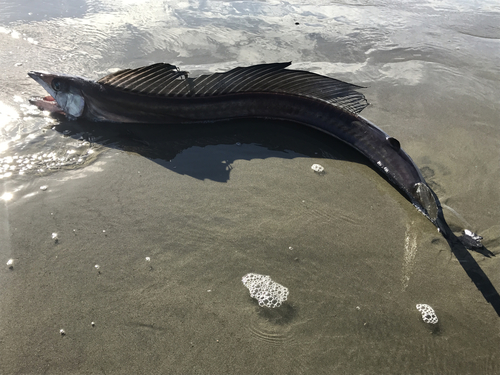
Longnose Lancetfish
The Atlantic bluefin tuna (Thunnus thynnus) is a magnificent and highly migratory species renowned for its size, speed, and commercial value. It plays a crucial role in the marine ecosystem and has been a prized catch for centuries.
Unknown Unknown years
Lifespan
215 cm
Length
Least Concern
Conservation Status
Unknown km/h
Swimming speed
Carnivorous
Diet
Pelagic Migration
Migration
Appearance Overview
The Atlantic bluefin tuna is a large, torpedo-shaped fish with a metallic blue back and a silvery-white belly.
Coloration
Dark metallic blue on top, silvery-white underside
Body Shape
Torpedo-shaped, streamlined
Fins
Two dorsal fins, the first depressible into a groove; small finlets behind second dorsal and anal fins
Length
Up to 13 feet (4 meters)
Weight
Up to 2,000 lbs (907 kg)
Diet
Carnivorous, feeding on a variety of fish, squid, crustaceans, and eels.
Feeding Behavior
Highly active predator, using speed and agility to hunt. They often hunt cooperatively, herding and feeding on schools of smaller fish.
Social Behavior
Forms schools, especially when young. Larger individuals can be more solitary, but still congregate during spawning.
Commercial Relevance
Extremely high value, particularly in the sushi and sashimi markets, where a single fish can fetch hundreds of thousands of dollars.
Conservation measures
Subject to strict fishing quotas and regulations, including minimum size limits and seasonal closures. International agreements and monitoring programs are in place.
Status
Endangered (Varies by population segment; some stocks are recovering, while others remain depleted)
Threats
Overfishing, primarily driven by demand for sushi. Bycatch in fisheries targeting other species is also a threat. Climate change may impact prey availability and migration patterns.
Habitat Distribution
Depth Range
0-1,000 meters (typically in the upper layers, but can dive deeper)
Geographic Range
Atlantic Ocean, Mediterranean Sea, and Black Sea. Divided into Western and Eastern stocks.
Preferred Environment
Temperate and subtropical waters; pelagic (open ocean), but also found in coastal areas.
Reproduction and Life Cycle
Breeding Habits
Spawns in warm waters; the two main spawning grounds are the Gulf of Mexico (Western stock) and the Mediterranean Sea (Eastern stock). Spawning typically occurs in spring and summer.
Development Stages
Eggs are pelagic (free-floating). Larvae develop rapidly, feeding on plankton. Juveniles grow quickly, forming schools.
Fecundity
Females can release millions of eggs per spawning season (up to 30 million). The number of eggs depends on the size and age of the female.
Maturity Age
Maturity age varies between stocks; Western Atlantic stock typically matures around 8-12 years, while Eastern Atlantic stock may mature earlier, around 4-5 years.
Faqs about Longnose Lancetfish
How long do Atlantic bluefin tuna live?
They can live up to 40 years, though this is becoming rarer due to fishing pressure.
How fast can they swim?
They are among the fastest fish in the ocean, capable of short bursts of speed up to 40-60 mph.
Are bluefin tuna warm-blooded?
Yes, they are warm-blooded, which allows them to maintain a higher body temperature than the surrounding water, aiding in muscle efficiency and speed.
Where do they spawn?
The Western Atlantic stock primarily spawns in the Gulf of Mexico, while the Eastern Atlantic stock spawns in the Mediterranean Sea.
Are bluefin tuna populations recovering?
While quotas and management plans exist, their high value and continued demand make enforcement challenging, and illegal fishing remains a concern.
What is the special ability of Atlantic bluefin tuna?
Atlantic bluefin tuna have a unique ability to maintain their body temperature above the ambient water temperature, which is unusual among fish.
How far do Atlantic bluefin tuna migrate?
Atlantic bluefin tuna undertake extensive migrations across the Atlantic Ocean, traveling thousands of miles between feeding and spawning grounds.
What is the role of Atlantic bluefin tuna in the marine ecosystem?
Atlantic bluefin tuna primarily feed on smaller fish, squid, and crustaceans, playing a key role as apex predators in the marine ecosystem.
What is the main reason for the decline in Atlantic bluefin tuna populations?
Atlantic bluefin tuna are listed as Endangered by the IUCN, with significant concerns due to overfishing and slow recovery rates.
Copyright @ Nature Style Limited. All Rights Reserved.
 English
English